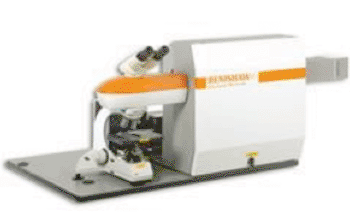Early Signs of Infection Detected by Plasmonic Nanoprobes
By LabMedica International staff writers
Posted on 08 Jul 2013
A silver-based nanoparticle has been developed for specific molecular markers that enter the bloodstream at the first stages of an infection.Posted on 08 Jul 2013
When light is directed at the sample, the nanoparticle attached to the molecular marker reflects a distinct optical fingerprint that can be used as a diagnostic tool.

Image: InVia confocal Raman microscope (Photo courtesy of Renishaw).
Biomedical engineers and genome scientists at Duke University (Durham, NC, USA) have developed a proof-of-principle approach using light to detect infections before patients show symptoms. Nanoprobes are used in conjunction with a phenomenon known as surface-enhanced Raman scattering (SERS). When light, usually from a laser, is shined on a sample, the target molecule vibrates and scatters back in its own unique light, often referred to as the Raman scatter, but this Raman response is extremely weak.
To prepare for the SERS molecular sentinel (MS) plasmonic nanoprobes, a DNA hairpin probe, complementary target and noncomplementary negative control oligonucleotides, were all synthesized by Integrated DNA Technologies (IDT; Coralville, IA, USA). Silver nanoparticles were prepared by using hydroxylamine hydrochloride as the reduction agent. The number of DNA probes attached to a silver nanoparticle was determined by a ligand exchange process. The fluorescence emission of the collected supernatants was measured using the FLUOstar Omega microplate reader (BMG Labtech, Inc.; Ortenberg, Germany). SERS measurements were performed using the InVia confocal Raman microscope (Renishaw; Wotton-under-Edge, UK).
The MS nanoprobes were able to detect the human radical S-adenosyl methionine domain containing 2 ribonucleic acid (RNA) target (RSAD2). The scientists were able show the feasibility and specificity of using the molecular sentinel technique to detect human DNA and RNA targets, which can be used as a novel host marker in response to viral respiratory infection.
Geoffrey S. Ginsburg, MD, PhD, a professor of medicine and pathology at Duke University, said, “This important proof-of-concept study now paves the way for the development of devices that measure multiple genome-derived markers that will assist with more accurate and rapid diagnosis of infectious disease at the point of care.” The study was published in the July 2013 issue of the journal Analytica Chimica Acta.
Related Links:
Duke University
Integrated DNA Technologies
BMG Labtech Inc.














